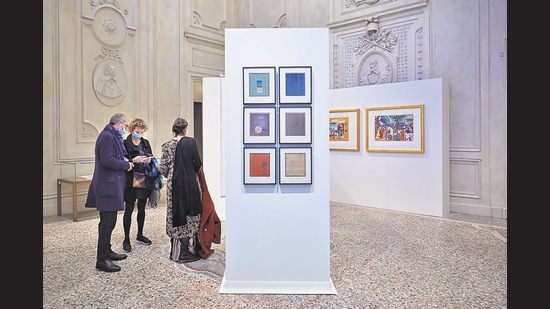After 20 months of existing in silos, with no offline exchanges of global art, the first major exhibition of Indian art abroad has taken the Italian city of Turin by storm.
Works by 65 Indian artists, borrowed from 10 Indian galleries, are being showcased from November 5 to January 15 in a multi-venue exhibition titled Hub India, with paintings, installation, textile and digital works spread across three iconic venues: the Palazzo Madama, the Museo d’Arte Orientale and Accademia Albertina di Belle Arti.
“The Kiran Nadar Museum of Art is delighted to partner with Hub India on an ambitious multi-part project, showcasing diverse strands of contemporary Indian art that juxtapose established and emerging practices for new and unfamiliar audiences in the Western world,” Kiran Nadar, founder and chairperson of the KNMA, said in a statement.

Curated by Myna Mukherjee and Davide Quadrio, the works are representative of multiple Indias and reflect the realities of the urban and rural, of farmers and women, their stories, ways of living and how they see the country. The exhibition also tells the story of an India richly entwined with its past.
In a striking comment on the farm crisis in rural India, and the protests that have lasted a year , Shambhavi Singh’s installation titled Chiriya Udd (Hindi for Bird, Fly) uses 480 iron sickles to represent a flock of birds in flight.
At Palazzo Madama, Turin’s museum of ancient art, Jayashree Chakravarty’s installation represents a floor-to-ceiling scroll and plays on ideas of memory and record-keeping. Titled Unfoldings: The Route Map of Experience, and made of paper, pigment, acrylic, glue and tea and coffee stain, it reflects her preoccupation with sentiment and the idea of mapping, combined with her larger concern for deteriorating habitats and unchecked human intervention, validated in the guise of progress and development. “Another story that is very relevant to India today,” says Quadrio.

At the Museo d’Arte Orientale, Nilima Sheikh’s Speaking of Akka, a work of Sanganeri hand-block print and paper, takes centre-stage. The series of six paintings draws on the tale of Akka Mahadevi, a 12th-century mystical poet from south India who left her husband and deemed herself married to the Hindu deity Shiva. “The series, in which the figure of Akka appears in abstract swathes of brushed colour, sets up a dichotomy between the spiritual and the corporeal, the mystical and the domestic, which bind the lives of women,” Mukherjee says.
Also on display are works by Bharti Kher, Gulammohammed Sheikh, Jogen Chowdhury, Laxma Goud, Ravinder Reddy, Sakti Burman and Waswo X Waswo, among others, on loan from the KNMA, Emami art gallery, Gallery Espace and other establishments.

“These voices rise sometimes in unison and sometimes in tension with each other at opposite sides of time, like a mirror, reversing the gaze upon a new, familiar but radical pastiche of liberation, ecology, urbanisation, migration, feminism, gender and subjectivity,” Mukherjee says.
The exhibition also includes an art film titled Sama (Latin for Similar), curated by Mukherjee and Quadrio and directed by Onir. The film, screened at the Accademia Albertina and headed to Delhi on December 9, explores the worlds of contemporary art in the Indian subcontinent and in Italy, offering glimpses into the aesthetics of the two regions by exploring histories, gender, archaeologies and politics as well as themes of migration, exile, time and memory and regional specificity in a globalised world.
Enjoy unlimited digital access with HT Premium
Subscribe Now to continue reading

Stay connected with us on social media platform for instant update click here to join our Twitter, & Facebook
We are now on Telegram. Click here to join our channel (@TechiUpdate) and stay updated with the latest Technology headlines.
For all the latest Art-Culture News Click Here
